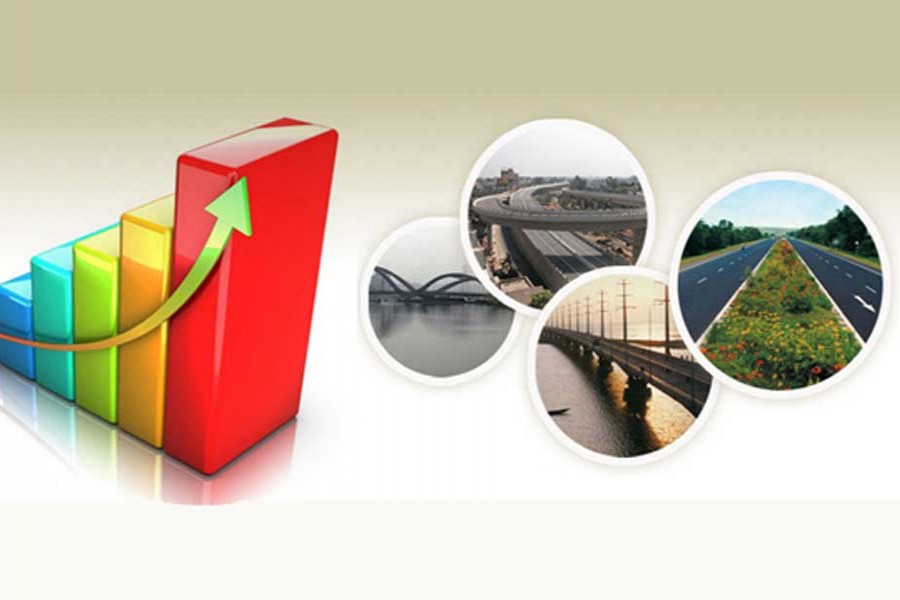Bangladesh grew at an average annual rate of 6.2 per cent – indeed an exhilarating rate in the annals of her history – for a decade or so. Then the growth rate jumped to a little over 7.0 per cent and further to about 7.3 per cent in the most recent years. The economy was forecast to grow at about 8.0 per cent in 2017-18, the highest ever rate in the country's history. Based on IMF and World Bank perceptions, relatively speaking, Bangladesh is to be one of the top 20 high growth performers of the last 10 years (2008-2017).
But the growth figures, be it a target or actual, always produced a wave of controversy. A 'tug of war' between a growth target set by the government of Bangladesh and those by the development partners, especially, the WB, the IMF and the ADB, seems to have narrowed down in recent years. It all started a few years back when the economic growth rate was said to have been achieved at 7.0 per cent. This claim cause to raise a few eyebrows as the economy has been growing at an average 6.2 per cent for a decade or so and there was no sign of structural improvement to grease such a 'high' growth rate. Critics alleged that the 'trick' of higher growth claimed by the government lay in the manipulation of the data prepared by the government agencies. However, the difference between government and other estimates generally hovered around about one percentage point.
Of late, the Asian Development Bank (ADB) came up with a revised version of the growth rate postulated earlier and praised Bangladesh for its performance on the economic front arguing that Bangladesh is on the right track to the fastest economic growth in the Asia-Pacific region in fiscal 2019-20, and thus praising government policies pursued so far. According to the multilateral donor agency, Bangladesh economy is expected to grow at 8.0 per cent this fiscal year (2018-19) – less than the government's own forecast of 8.13 per cent – and is likely to remain the same in the next fiscal year also. It may be mentioned here that earlier in September last year, the said institution projected a growth rate of 7.5 per cent in 2018-19.
"But thanks to the robust private consumption, increased public investment, strong export performance and expansion in industries the ADB has revised upwards its growth forecast by 50 basis points." About the current account deficit – a concern gravely grounded by the media and academics, the ADB puts up a plain justification: "The current account deficit widened due to the surge in import demand, but it was mainly from the increase in imports of intermediate and capital goods, which will boost short- to medium-term production".
Some of the positive aspects also need mention: "Continued favourable trade prospects, stronger performance of exports and remittances and heightened public investment for expeditious implementation of large infrastructure projects account for the multilateral lender's sanguinity on the Bangladesh economy in the near term.... Bangladesh's economic outlook remains optimistic in the short-run. But to sustain this momentum in the medium- to long-term, there are several challenges we need to overcome",
So far so good. But a plethora of policies are needed to be materialised to see that Bangladesh is on a higher growth trajectory to reach a single digit poverty rate such as "expanded industrial base, diversified export basket, improved business environment for vibrant private sector development, expanded tax base, better revenue collection for increased resource allocation and human capital development."
"Continued focus on prudent macroeconomic policies, sound debt management, strengthening the banking sector, removing infrastructure constraints and reducing the cost of doing business are important to help achieve the long-term development vision of the country,"
By and large, according to the ADB, Bangladesh is on the right track to grow faster in coming years. However, the challenges observed by the ADB include, inter alia, the high non-performing loan ratio, low profitability, weak governance, widening capital shortfall, operational inefficiency and ineffective legal framework. We reckon that one more important challenge is to reduce inequality. Sustained growth has not been associated with declining income inequality. However, high growth rate heightened inequality of income that depicted discernible upward trend with periodic fluctuations. It means that high inequality has been dampening the power of growth in reducing poverty. What is then growth for if it fails to lower poverty?
High growth to accompany low inequality requires structural reforms - a second generation reforms so to say - which are seemingly missing from the mindset of policymakers. Inequality is an outcome of illegal possessions of income and wealth but the institutions to look after illegal transactions are very weak, politicised and not equipped with qualified personnel. It is therefore needed that we make the judiciary, the media, the ACC, the ECC as free as possible to guard against illegal accumulation of income and wealth and thus gift a growth with social justice. WE definitely need higher growth rate but not at the cost of high inequality that costs human lives.
Abdul Bayes is a former Professor of Economics at Jahangirnagar University.
Abdul [email protected]


